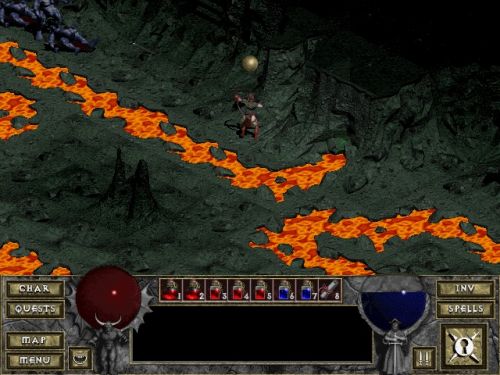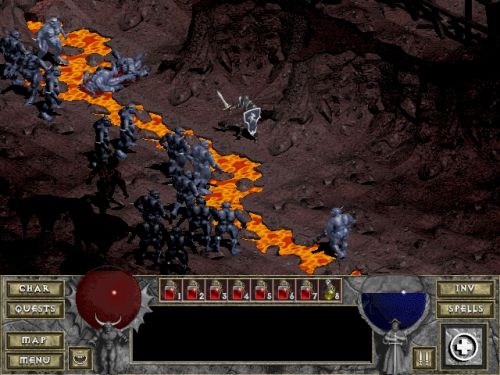
The biggest difference from one character to the next, regardless of class, is undoubtedly the spells available to them. You learn spells by using books; as you read more books of a particular skill, the spell becomes more effective. These precious spell books drop randomly, so you can’t really plan ahead for what your character will be able to do. If you want your Sorcerer to sling fireballs left and right, that’s great... as long as you find enough books of Fireball. You may end up with a ridiculously high level in Charged Bolt or something else instead. This reliance on finding books isn’t necessarily a bad thing, as it makes every playthrough quite unique.
Diablo's setting, the town of Tristram, is quite small, and consists of only a church and a few smaller buildings. It is a simple village where the player interacts with various NPCs in order to purchase items, make repairs, and otherwise rest in between trips to the dungeon. Most of the action takes place in the sixteen levels beneath Tristram. Players begin their quest in the Church, followed by the Catacombs. Deeper down, the Caves lead to Hell itself, where Diablo is finally confronted. The dungeon level layouts, as well as the minions of Diablo who inhabit them, are randomly generated each playthrough. While Diablo certainly wasn’t the first game with random dungeons, by including them, the game’s replayability was greatly enhanced.

The original Diablo was more loot-based than the sequels would be. Remember that spells themselves were an item drop, meaning you had to keep searching in order to improve. The random treasure drops, with the famous prefix and suffix traits (Godly Plate of the Whale, anyone?) also kept you slaying Diablo’s cronies in order to improve your character long after you first beat the game. I remember spending hours starting new games just to visit Griswold’s shop in the hopes of finding a fantastic item like a King’s Longsword of Haste. The allure of finding the next item to make your character perfect is one of the biggest reasons for Diablo’s success.
And the co-op! It was glorious. Many different strategies emerged in team play, from as simple as “divide and conquer” to the classic “warrior tanks, sorcerer and rogue attack from afar” tactics. The options for connecting to your friends were robust, including LAN play, Dial-up modem, and, best of all, online play via battle.net (more on this important innovation later). You could even install a spawn version of the game, so more than one player could enjoy a limited version of the game even from one CD. Diablo was great alone, but became something truly special in co-op with your pals.